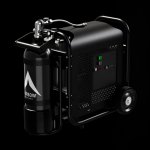DeformedTree
Member
- Joined
- May 19, 2018
- Messages
- 1,397
yeah, it looks neat, and well "obvious". I hadn't realized it didn't just have an air port on it. I thought you just go back and forth to a compressor and top it off. Figuring the big thing was making a lightweight tank. But yeah, to get much energy, it will need to be very high pressure. Not crazy about a really high pressure tank around my like that with it getting tossed around.
I would hope if it needs a special pressure boost, it would be an inline deal, and air pump powered by normal compressor air, which runs just a simple compressor to boost high pressure, so it's not a whole other compressor involved.
In many ways its the "air powered car", yes, you can make one, it's just you can't pack a usable amount of energy in one, unless going a mile or 2 is all you want from it.
I would hope if it needs a special pressure boost, it would be an inline deal, and air pump powered by normal compressor air, which runs just a simple compressor to boost high pressure, so it's not a whole other compressor involved.
In many ways its the "air powered car", yes, you can make one, it's just you can't pack a usable amount of energy in one, unless going a mile or 2 is all you want from it.



